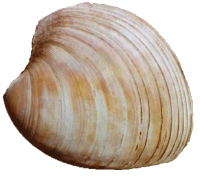Shell amulets were once thought to ward off ill health, infertility or bad luck. Shells have also been ground up for use in potions and for various medicinal uses throughout history. Today the shell, its living flesh and by products are being studied and used in many areas of medicine. Some examples:
|
 Miscellaneous cones |
 Mercenaria mercenaria |
|
- Paolin, a drug made from abalone juice, is an effective inhibitor of penicillin- resistant strains of bacteria, such as Staphylococcus aureus, Streptococcus pyogenes, Salmonella typhus and parathyphoid A & B bacteria.
|
 Olympia Oyster (Ostrea conchaphila) |
|
Common Names: The Common Mussel,Common bay mussel,blue mussel |
|
|
The cement of the Carrier Shells (Xenophoridae) is being studied for use as a possible cement for bone fractures. (Note: The Carrier shells are the camouflage experts of the mollusc world: they attach all kinds of objects - shells, rocks, pieces of coral, sponges, bottle caps. to their shells, so they look like a little pile of trash on the bottom of the sea - a great way to avoid being eaten! Shell shown is the Xenophora (Xenophora) mekranensis konoi Habe. Picture courtesy of: Sharpe Shells |
 |
- Powdered mother of pearl is sold in the markets of the Peruvian Andes to promote healing of wounds (unproven). (Note: Mother of pearl is the beautifully iridescent interior of some bivalves, which the mollusc also uses to surround small, irritating objects which get inside its mantle, or outer body - forming a pearl!)
- Traditional medicine in Vietnam has a wior shells: powdered oyster shell is taken to treat acid indigestion, fatigue and to stop hemorrhage. It is also sprinkled over open wounds and boils. Cuttlefish bones are used as a remedy for rickets, a healing agent in the treatment of gastro-intestinal troubles, a local anti-hemorrhagic (i.e., it stops internal bleeding), and as an antiseptic is cases of inflammation of the middle ear. The flat shell of the Abalone, with its iridescent inside, is powdered and taken orally to improve vision, to remove keratoses (cataracts), and to improve such conditions as hemeralopia (where you can see at night well, but hardly at all in the daytime! Powdered pearls from oysters are used as a topical eye medicine (i.e., you put it right on your eyes!!), and it has been scientifically proven to have some anti-inflammatory effects on a painful condition called conjunctivitis, where the surface of the eye becomes red and sore
